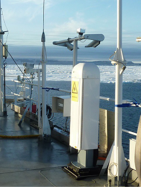Jussi Paatero
The height to the lowest cloud base, or to more than one cloud base in the case when the lowest cloud layer does not cover the whole sky, was measured by three laser ceilometers. One of these ceilometers was provided by FMI (Finnish Meteorological Institute), located on the back of the starboard side of the 7th deck of the Icebreaker Oden, and was only operated during the ice drift. When the attenuation of the laser beam reaches a threshold, like in a dense fog, it switches to reporting “vertical visibility”, rather than cloud-base height.
Download data
Visit web site
Citation
Jussi Paatero (2018) Ceilometer measurements, FMI, from the high-Arctic ASCOS expedition 2008. Dataset version 1. Bolin Centre Database. https://doi.org/10.17043/oden-ascos-2008-ceilometer-fmi-1
References
Tjernström, M. et al. 2014. The Arctic Summer Cloud Ocean Study (ASCOS): overview and experimental design. Atmospheric Chemistry and Physics, 14, 2823–2869. https://doi.org/10.5194/acp-14-2823-2014
Data description
ASCOS Ceilometer data, Measurement method: Vaisala CT25K onboard Oden, 7th deck
Comments
The height to the lowest cloud base, or to more than one cloud base in the case when the lowest cloud layer does not cover the whole sky, was measured by three so-called laser ceilometers. The laser pulse is essentially only reflected in cloud particles and preferentially by liquid water droplets, and is not sensitive to precipitation.
Cloud base heights are given from the surface to the level into the cloud base where the backscatter of the laser light reaches a predetermined level; hence ceilometers from different manufacturers may show slightly different results. Cloud fraction are usually reported in octas; 8 octas is completely cloudy. When the attenuation of the laser beam reaches a threshold, like in a dense fog, it switches to reporting “vertical visibility”, rather than cloud-base height, and the cloud fraction is set to 9. Note that cloud fraction < 9 does not imply absence of fog; the laser beam may on occasion burn through a thin fog layer and detect a higher cloud base aloft.
In addition to the laser ceilometers, a so-called “all-sky cloud imager” ASCOS was also deployed. This consists of a polished half-spherical dome mirror with a camera on top looking down; the camera takes images of the dome, which reflects the whole sky (except the little angle where the camera itself blocks the view). Interpretations of the images results in estimates of cloud type and cloud fraction. Data may be lost if dew or precipitation contaminates the dome.
One ceilometer was operated as part of Oden’s weather station, located on the deck on 7th deck (~25 m above water) on the starboard side. This system was operated through the whole expedition.
A second ceilometer (NOAA) was located by the cloud-radar container, on the roof of Oden’s foredeck lab. This system additionally recorded the actual backscatter profile, and hence serves as a “poor-man’s lidar”.
A third ceilometer (FMI) was located on 7th deck, on the back of the starboard side. This system was only operated during the ice drift.
The “all-sky camera was mounted on the roof of the port container on the 7th deck.
FMI is the Finnish Meteorological Institute.
Original address: http://www.ascos.se/index.php?q=node/273
Files:
ASCOS_Ceilometer_data_FMI.xls (3.99 MB)
